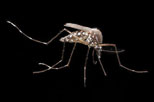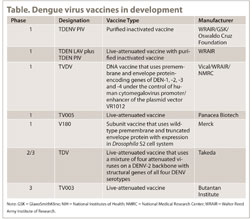Dengue: The beginning of the end?
Dengue viruses have been on the march for more than 100 years. Dengue originated in monkeys and spilled over into humans as long as 800 years ago. It was restricted to Africa and Southeast Asia until the mid-20th century. The dengue viruses in viremic individuals and their Aedes aegypti mosquito vectors spread throughout tropical Southeast Asia via maritime shipments.


The clinical picture of “breakbone fever” became more serious in the 1960s as cases of severe dengue (dengue hemorrhagic fever; DHF) and dengue shock syndrome occurred during epidemics in Southeast Asia. According to WHO, about 2.5 billion people — 40% of the world’s population — currently live in areas where there is a risk of dengue transmission. Dengue is endemic in at least 100 countries in Asia, the Pacific, the Americas, the Caribbean and Africa, with estimates that 50 to 100 million infections occur yearly, resulting in 500,000 DHF cases and 22,000 deaths, mostly among children. These numbers underestimate the global burden of dengue, because many infections are asymptomatic (but can serve as infectious blood meals for mosquitoes) or may be misdiagnosed as febrile diseases of other etiologies such as chikungunya, Zika virus or malaria.
Successful efforts to eliminate urban yellow fever in the Americas by controlling the A. aegypti mosquito in the first half of the 20th century virtually eliminated dengue fever there. Dengue reappeared in the Caribbean in the early 1960s, spread through the islands and then into tropical and subtropical mainland countries of the Americas, becoming a significant public health problem starting in the early 1980s. The efforts to eradicate A. aegypti ended about this time, and the mosquito rapidly became reestablished in the American tropics and subtropics and was transmitting all four dengue virus serotypes (DENV-1, -2, -3 and -4). Brazil reported 1.2 million dengue cases in the first 4 months of 2016. Both classical dengue fever as well as DHF occurred across the Americas and continue to the present time.
US and its territories
Over the past decade, viremic travelers have brought dengue viruses to the United States. In 2016, there were 764 confirmed dengue cases, most imported into the U.S., with no DHF or deaths. However, in recent years, there have been a few locally transmitted sporadic cases and small outbreaks in Florida and south Texas where populations of A. aegypti occur, and in Long Island, New York, where A. albopictus was the vector.

Source: Army Medicine/Flickr
A relatively large dengue outbreak occurred in September 2001 in Hawaii, where 1,644 persons had locally acquired dengue-like symptoms, of whom 122 were laboratory-confirmed. DENV-1 was isolated from 15 patients. There were no cases of DHF or shock syndrome in the outbreak. Phylogenetic analyses showed the Hawaiian isolates were closely associated with contemporaneous isolates from Tahiti. A. albopictus was present in all communities surveyed on Oahu, Maui, Molokai and Kauai; no A. aegypti were found. The outbreak illustrates how the virus can be moved from a distant area of ongoing transmission to a new locality where mosquito vector populations are abundant enough to initiate an outbreak.
In U.S. territories, most dengue cases occur in Puerto Rico, the U.S. Virgin Islands, Samoa and Guam, which are endemic for the virus. Dengue and DHF have been a significant problem in Puerto Rico, where large outbreaks have occurred since the late 1960s. A recent islandwide epidemic occurred in 2007, with more than 10,000 cases. In Puerto Rico, as in most of the Caribbean Basin, the dengue virus vector is A. aegypti, which is abundant year-round. Dengue transmission in Puerto Rico follows a seasonal pattern with low transmission in March through June and high transmission in August through November. The frequent travel of individuals from Puerto Rico to the continental U.S. represents a significant potential source of introduced virus.
In the mainland U.S., A. aegypti inhabit the South, whereas A. albopictus has a broader range and can overwinter as diapaused eggs in more temperate Eastern and Central states. Although there is a risk that viremic individuals can introduce dengue viruses into the states where these mosquito vectors are present, the kinds of serious outbreaks that occurred in Hawaii and in South and Central America and Mexico have fortunately not occurred in the U.S. because air conditioning and screened doors and windows limit numbers and movement of the mosquito vectors.
Significant outbreaks in the continental U.S. by any of the four dengue viruses are unlikely in the near future. However, the only way to avoid introduction of these viruses into areas with mosquito vectors in the U.S. is to reduce or halt dengue virus transmission in tropical and subtropical areas around the world. This can be done through control of mosquito vector populations or by maintenance of a high degree of immunity in susceptible populations through vaccination in these areas.
Vector control
Vector control has been a difficult challenge since DDT use was banned in the U.S. in 1972. Fogging with insecticides kills adults for a short time, and new adults emerge quickly from breeding sites. Incorporation of larvicides such as Abate in breeding sites, or the elimination of those sites themselves, improves control efforts. Both are labor intensive and require active community participation, something that is difficult to sustain over the long term. Because A. aegypti can take advantage of any water catchment, however small, that lasts for 10 or more days, elimination of these breeding habitats is often an arduous task. Even though this species is dependent on human habitations and buildings, breeding sites can be occult, difficult-to-find and are often overlooked.
Two new vector control approaches are being tested in the field currently. One, developed by Oxitec, involves the release of genetically modified male A. aegypti. A self-limiting gene is inserted into the mosquitoes, and the gene is passed on to the insect’s offspring. When male engineered mosquitoes are released into the wild and mate with wild females, their offspring inherit the self-limiting trait and the larvae die before reaching adulthood, resulting in local population decline. This approach has been used successfully in pilot field trials resulting in a reduction of the mosquito population and dengue virus transmission, and it has recently been approved for a pilot test in the Florida Keys, where the risk of Zika virus transmission is a concern. The advantage of this approach is that the mosquitoes do all the work in finding breeding sites after their release. The disadvantage is that continuous release of modified male mosquitos is required to keep the population from rebounding.
A second approach to vector control is the establishment of Wolbachia bacteria in the guts of the mosquitoes, which blocks infection by dengue, Zika and chikungunya viruses. Wolbachia live inside only insect cells and occur naturally in up to 60% of all insect species as well as many mosquito species, although not usually in Aedes mosquitoes. Although a broad range of insects carry Wolbachia, the bacteria are not infectious and cannot be transmitted to animals, including humans. Wolbachia can be transmitted only from parent to offspring inside the female’s egg. It spreads into insect populations by altering the reproductive success of the insect that carries it. When a male mosquito that carries Wolbachia mates with a female without the bacteria, the female’s eggs do not hatch. Wolbachia-infected female mosquitoes do not suffer adverse effects and produce normal numbers of offspring that carry Wolbachia, which, in turn, block infection by the target viruses. Initially, this reproductive effect will be very small because there will be few Wolbachia-infected mosquitoes in the population, but over successive generations, the numbers of male and female mosquitoes infected with Wolbachia will increase. The advantage using Wolbachia bacteria is that once they are introduced into the mosquito population, they can be maintained without constant re-releases. Again, the mosquitoes do the work of finding breeding sites. This approach is being tested currently in the field in several countries, including Australia, Brazil, Columbia, Indonesia and Vietnam.
Vaccines
Vaccine development is complicated by the need to include all four dengue serotypes for simultaneous administration. There is concern regarding the risk for antibody-dependent enhancement (ADE) of infection that could result in more severe disease. ADE occurs after recovery from infection by one dengue virus, which elicits lifelong immunity against that particular virus serotype but confers only partial and transient protection against subsequent infection by any of the other three dengue viruses. These cross-reactive antibodies do not neutralize the virus but facilitate virus attachment and entry into susceptible cells. Subsequent infections increase the risk for developing severe dengue. Interestingly, because dengue and Zika virus have related antigens, there is concern that this same phenomenon of ADE may occur with the use of a Zika virus vaccine (when one is developed), which may enhance dengue disease. There is also the question of whether dengue vaccines would enhance Zika virus infections because of ADE.
The dengue vaccine field is very active. One vaccine, Dengvaxia (CYD-TDV, Sanofi Pasteur), is currently being used and others are in development (Table). The approaches include live-attenuated, subunit, DNA and purified, virus-vectored, and virus-like particle-based vaccines.
CYD-TDV is a live-attenuated vaccine with a yellow fever virus backbone carrying prM and E protein genes from wild-type DEN-1, -2, -3 and -4. It was first licensed for use in Mexico and is now approved in 14 countries: Bolivia, Brazil, Cambodia, Costa Rica, El Salvador, Guatemala, Indonesia, Mexico, Paraguay, Peru, Thailand, Singapore, Venezuela and the Philippines. The overall efficacy in two trials was 59% and for severe dengue was 79%. Efficacy varied by serotype and was higher against DEN-3 and -4 (71.6% and 76.9%, respectively) than against DEN-1 and -2 (54.7% and 43%, respectively). There is some concern about use of this vaccine because it may increase disease severity in locations with lower infection rates and in younger children, according to recent study findings.
One hopes that a combination of effective vector control and vaccines that can produce solid immunity against all four dengue viruses can significantly reduce the incidence of dengue fever and severe dengue around the tropical and subtropical world. Once these biological challenges are successfully met, it will be necessary to deal with the financial ones. Who is going to pay for this international effort?
- References:
- Bhatt S, et. al. Nature. 2013;doi:10.1038/nature12060.
- Brady OJ, et al. PLoS Negl Trop Dis. 2012;doi:10.1371/journal.pntd.0001760.
- CDC. Dengue. https://www.cdc.gov/Dengue. Accessed March 7, 2017.
- Effler PV, et al. Emerg Infect Dis. 2005;11:742-749.
- Halstead SB, O’Rourke EJ. J Exp Med. 1977;doi:10.1084/jem.146.1.201.
- Joubert DA, O’Neill SL. PLoS Negl Trop Dis. 2017;doi:10.1371/journal.pntd.0005275.
- Viennet E, et al. PLoS Negl Trop Dis. 2016;doi:10.1371/journal.pntd.0004943.
- Wang TT, et al. Science. 2017;doi:10.1126/science.aai8128.
- WHO. Dengue control. http://www.who.int/denguecontrol/en. Accessed March 7, 2017.
- For more information:
- Donald Kaye, MD, MACP, is a professor of medicine at Drexel University College of Medicine, associate editor of the International Society of Infectious Diseases’ ProMED-mail, section editor of news for Clinical Infectious Diseases and an Infectious Disease News Editorial Board member.
- Thomas M. Yuill, PhD, is a ProMED virus diseases moderator and professor emeritus, department of pathobiological sciences and department of forest and wildlife ecology, University of Wisconsin-Madison.
Disclosures: Kaye and Yuill report no relevant financial disclosures.


